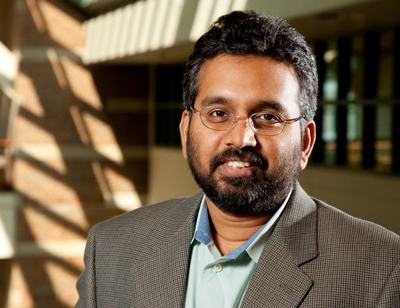Article

When Narayana Aluru received a job offer at the University of Illinois in 1998, he asked his Ph.D. adviser at Stanford if he knew anyone at Illinois who could provide guidance as he started his career. The adviser reached out to two professors who agreed to meet the young scientist.
Aluru still recalls his good fortune at stepping into the Beckman Institute to meet Karl Hess and Umberto Ravaioli, whose influence continues to inspire him 20 years later.
“My first thought was how impressive the building was,” he said of the Beckman Institute. “Then I met Karl and Umberto and realized the people and the opportunities for collaboration were even more impressive.”
Both men were professors of electrical and computer engineering at the time. Ravaioli, whose primary interest is nanotechnology, is now a senior assistant dean in the College of Engineering. Hess, a foremost expert in electron transport and a research group co-chair, retired in 2006.
“I didn’t learn until much later that Karl was one of the founding members of the Beckman Institute,” Aluru said. “They were both so gracious and interested in my research. Karl said my work would be a good fit with Beckman’s focus on interdisciplinary research and invited me to become an affiliate.”
The rest, as they say, is history. “When I came to Illinois, I had a vision of my career path,” Aluru said. “I had a five-year plan and a 10-year plan. And though I did pursue that plan, my research career really has been shaped more by the collaborations and opportunities that have come about as a result of my affiliation with Beckman. The big questions my research has focused on have been influenced by Karl and Umberto and so many other talented colleagues here.”
Why Beckman?
“Being part of the Beckman Institute really shapes a scientist’s research career. The intellectual atmosphere, the vibrant collaborations, and the infrastructure create possibilities that lead to significant scientific contributions.”
—Narayana Aluru, Computational Molecular Science Group
Studying Nanosystems
What are some of those questions and who are some of those collaborators?
The early questions were about nanofluidics, that is, how fluids behave in very small regions. Hess and Ravaioli introduced Aluru to their approaches on how biological ion channels work, which informed his research and furthered his Beckman collaborations.
In the years that followed, Aluru, a professor of mechanical science and engineering, and his research group within the Computational Multiscale Nanosystems Group have focused on advancing the field of computational nano-technology by developing new computational methods at various length scales and employing them to understand fundamental issues in nanofluidics, nanoelectromechanical systems, nanomaterials, and nanobiotechnology.
“We focus on wide-ranging applications, such as water desalination, energy storage and production, water-energy nexus, electromechanical sensors and actuators, DNA and protein sensing and sequencing, and nanopower generation,” Aluru said.
With Beckman collaborators Joe Lyding, a professor of electrical and computer engineering, and Arend van der Zande, an assistant professor of mechanical science and engineering, as well as SungWoo Nam, an associate professor of mechanical science and engineering, Aluru is investigating mechanical and electrical properties of emerging materials, such as 2D materials, for potential applications as ultra-sensitive sensors and electronic devices.
Extending Collaboration
Other Beckman collaborations include Aluru’s work with Emad Tajkhorshid, a professor of biochemistry. “Our group collaborated with Emad’s group on understanding rapid water permeation in aquaporins,” Aluru said. “Specifically, we developed thermodynamic insights into unique water transport properties of aquaporins. We are also collaborating on understanding proton transport in confined environments.”
In addition, he has partnered with Rohit Bhargava, a professor of bioengineering, over the years on microfluidics research. “More recently, we have been collaborating on chemical reactions in microfluidic channels,” Aluru said. “We plan to continue our collaboration by integrating uncertainty quantification and stochastic approaches into simulation of microfluidic platforms that Rohit is developing.”
Today, Aluru continues his work with Ravaioli as well, focusing on cyber-physical
issues. He also is a collaborator on the new nanomanufacturing node recently awarded to the University of Illinois by the National Science Foundation. On that project, he collaborates with Ravaioli as well as Beckman affiliate Kimani Toussaint, an associate professor of mechanical science and engineering.
It’s been a busy 20 years since Aluru first stepped foot inside the Beckman Institute and met with Hess and Ravaioli.
“I hope to continue to contribute and benefit from the vibrant and intellectual atmosphere at Beckman, and I hope I can inspire younger faculty to engage in exciting research at Beckman, just the same way I was inspired by senior faculty at Beckman when I was a younger faculty member,” he said.
Beckman Institute for Advanced Science and Technology